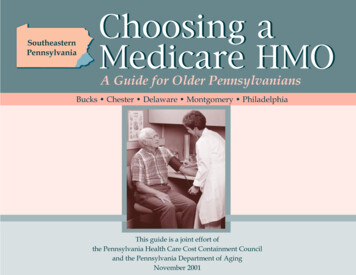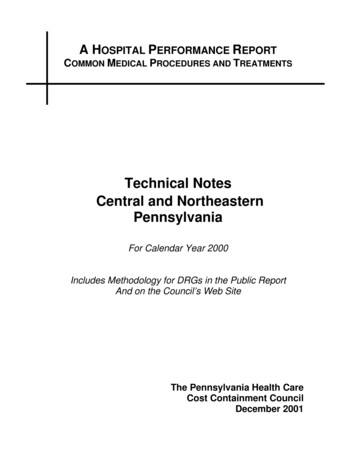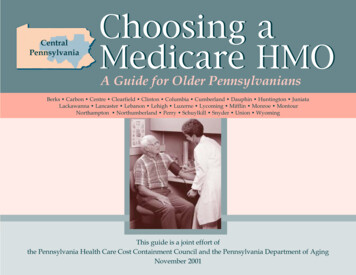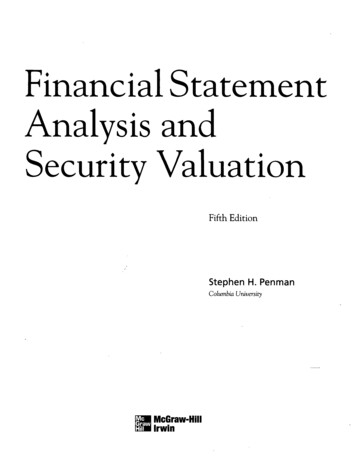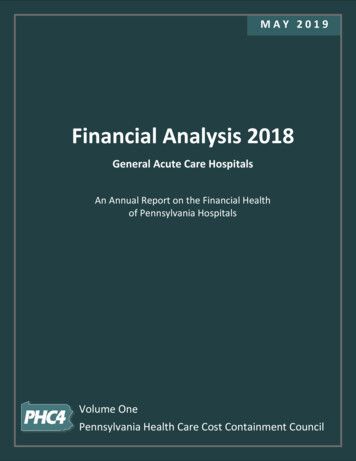
Transcription
MAY 2019About PHC4Financial Analysis 2018state. It was created in the mid-1980s when Pennsylvaniabusinesses and labor unions, in collaboration with other keyd forces Acuteto enactmarket-orieGeneralCareHospitalscare reforms. As a result of their efforts, the General Assemblypassed legislation (Act 89 of 1986) creating PHC4.An Annual Report on the Financial HealthPHC4’s primary goalofisPennsylvaniato empowerHospitalspurchasers of health carebenefits, such as businesses and labor unions, as well as otherstakeholders, with information they can use to improve qualityand restrain costs. More than 840 thousand public reports onpatient treatment results are downloaded from the PHC4website each year. Additionally, nearly100 organizations andVolume OnePennsylvania Health Care Cost Containment Council
FINANCIAL ANALYSISAbout PHC4The Pennsylvania Health Care Cost Containment Council (PHC4)is an independent state agency charged with collecting, analyzing,and reporting information that can be used to improve the qualityand restrain the cost of health care in the state. It was created inthe mid-1980s when Pennsylvania businesses and labor unions, incollaboration with other key stakeholders, joined forces to enactmarket-oriented health care reforms. As a result of their efforts, theGeneral Assembly passed legislation (Act 89 of 1986) creating PHC4.PHC4’s primary goal is to empower purchasers of health carebenefits, such as businesses and labor unions, as well as otherstakeholders, with information they can use to improve quality andrestrain costs. More than 840 thousand public reports on patienttreatment results are downloaded from the PHC4 website each year.Additionally, nearly 100 organizations and individuals annuallyutilize PHC4’s special requests process to access and use data.Today, PHC4 is a recognized national leader in public health carereporting.PHC4 is governed by a 25-member board of directorsrepresenting business, labor, consumers, health care providers,insurers, and state government.
FINANCIAL ANALYSISA high-quality, cost-effective health caredelivery system requires financially healthyhospitals and health systems. Since fiscal year1989, the Pennsylvania Health Care CostContainment Council (PHC4) has produced aseries of financial reports measuring thefinancial condition and utilization of theCommonwealth’s hospitals and health systems.Volume One presents a financial profile ofPennsylvania’s general acute care (GAC)hospitals.Volume Two provides financialinformation about ambulatory surgery centers,and Volume Three addresses non-GAC(rehabilitation, long-term acute care, psychiatricand specialty) hospitals.The GAC hospital data included in VolumeOne is, for most GAC hospitals, on a fiscal year2018 (FY18) basis. FY18 began on July 1, 2017and ended on June 30, 2018. A small number offacilities operate on a December 31 orSeptember 30 fiscal year end.Information contained in this report wasderived from annual hospital financialstatements, supplemented with additional datasupplied by each hospital. Every reasonableeffort has been made to ensure the accuracy ofthe information contained herein. Each facilityhad the opportunity to review its data and tomake corrections. The responsibility for dataaccuracy lies with each hospital.Table of ContentsReport Highlights .1Hospital Income .2Statewide Margins .4Uncompensated Care Levels .6For-Profit GAC Hospitals .8Average Days in Patient Accounts Receivable.10Hospital Utilization .11Statewide Utilization .11Revenue by Payer .13Individual Hospital Data .16Explanation of Terms & Measures .33Footnotes .342018 Financial Analysis Volume Onei
REPORT HIGHLIGHTSReport HighlightsPennsylvania General Acute Care Hospitals Fiscal Year 2018 Net Patient Revenue: The revenue hospitals received for patient care increased 3.9% during FY18.Statewide net patient revenue was 45.3 billion during FY18, making up 94% of statewide hospital totaloperating revenue. Patient Accounts Receivable: On a statewide basis, the amount of time the average bill remained inaccounts receivable increased from 45 days in FY17 to 46 days in FY18. Operating Margin: Statewide operating income decreased from 2.4 billion in FY17 to 2.3 billion inFY18. As a result, the statewide average operating margin decreased from 5.15% in FY17 to 4.76% inFY18. Total operating revenue increased to 48.0 billion and operating expenses increased to 45.7billion in FY18. Total Margin: The statewide total margin realized by the hospitals decreased slightly by 0.05percentage points, from 6.67% in FY17 to 6.62% in FY18. Uncompensated Care: The statewide percentage of uncompensated care to net patient revenue hasbeen steadily decreasing each year since FY13. The percent of uncompensated care to net patientrevenue decreased from 1.76% in FY17 to 1.66% in FY18. The foregone dollar value for statewideuncompensated care has fallen from 766 million in FY17 to 750 million in FY18.OperatingMarginFY18TotalMarginFY183-year AvgTotal MarginFY16-FY18Percent ofUncompensatedCareFY18Medicare Shareof Net PatientRevenueFY18MedicalAssistance Shareof Net PatientRevenueFY18Region 14.62%5.40%5.38%1.65%38.99%13.71%Region 23.30%4.00%2.62%1.87%47.00%13.22%Region 32.88%3.94%4.53%1.49%47.08%12.07%Region 410.56%10.76%10.70%1.47%33.41%8.56%Region 57.03%8.53%9.37%2.38%32.87%9.28%Region 66.17%8.65%6.86%1.81%39.45%11.11%Region 78.65%9.15%7.45%1.31%34.89%8.55%Region 82.16%5.21%5.31%1.58%40.34%9.96%PHC4RegionRegion 2%6.43%1.66%34.89%13.88%2018 Financial Analysis Volume One1
HOSPITAL INCOMEPennsylvania GAC HospitalsThe Commonwealth of Pennsylvania licensesgeneral acute care (GAC) hospitals, includingspecialty acute care hospitals, to offer medicaland/or surgical services to the public. A GAChospital provides care to patients who requirehospitalization for more than 24 hours, and mayoffer emergency care. Many GAC hospitals operatesubunits, such as skilled nursing, psychiatric,rehabilitation, and long-term acute care, which areincluded in the information presented in this report.Ancillary operations, such as physician practicegroups, were excluded whenever possible.There were 168 licensed GAC hospitals inPennsylvania that operated during at least someportion of fiscal year 2018 (FY18). There were 169GAC hospitals operating during the prior year. Onehospital merged into another hospital betweenreporting periods, Palmerton Hospital in CarbonCounty merged into Blue Mountain Hospital.This report includes statewide and regionalanalysis based on data for all GAC hospitals. Theindividual hospital data tables include data for all168 GAC hospitals that operated during FY18.Hospital IncomeHospitals need positive income levels (totalmargin) to operate effectively. Those that have anegative total margin, or deficit, are not receivingsufficient revenue to pay all of their expenses.Hospitals operating at a deficit must find othersources of revenue, such as debt restructuring,charitable donations, or endowments, etc., or reviewspending patterns to find ways to save on costs.Such improvements are necessary to replace wornout or obsolete equipment and buildings, keep pacewith changes in medical technology, and meet acommunity’s changing health care needs.In addition to using their own funds, hospitalsfinance improvements to facilities and equipmentby issuing bonds or entering into other debtfinancing.Financial institutions and potentialbondholders, however, must believe that a hospitalis capable of repaying its debt. Hospitals projectedto have low or negative income may encounterdifficulty borrowing money.The level of income needed to keep a hospitalfinancially healthy will be different for eachhospital or health system. The precise amount ofincome a hospital needs depends on several factors,including, but not limited to: the condition of itsplant and equipment, the amount of debt, assetsavailable for capital improvements, the mix of careprovided by the hospital, the level of payment risk,and the current and future needs of the market ahospital serves.For example, a hospital that has experiencedlow or negative income levels for a number of yearsmay need to realize an above-average income levelif it is to make overdue capital improvements,reduce outstanding debt, and replenish capitalreserves. Alternatively, a hospital with a history ofcontinuous moderate income levels in all likelihoodcan maintain operations with a lower income levelif it has kept pace with needed improvements andhas not depleted its capital reserves or acquired debtin order to meet expenses.Hospitals need to receive sufficient income tobe able to improve their facilities and equipment.2018 Financial Analysis Volume One2
HOSPITAL INCOMEFigure 1Statewide Operating and Non-Operating IncomeOperating Margin & Total MarginHospital income is usually expressed as eitheroperating margin or total margin.Operating margin reflects the percent ofoperating revenue remaining after all operatingexpenses are paid (operating income). A hospital’soperations include patient care and other relatedfunctions, such as medical education, cafeteriaservices, community health education and screeningprograms, and parking services.A positiveoperating margin indicates that operating revenuesexceed operating expenses.Alternatively, anegative operating margin indicates that revenuesare not covering costs.To cover operatingexpenses, hospitals with a negative operatingmargin, for instance, may use funds that werereserved to replace obsolete or worn out facilitiesand equipment.Total margin reflects the percent of net income,which is both operating income and income from allother sources (non-operating income). Examples ofnon-operating income include investment gains,trust income and contributions. However, somehospitals may include all or part of investment andtrust income in operating revenue, specificallywhen the funds have been designated to supportspecific operations of a hospital.Total margin reveals the composite financialhealth of a facility during the year. If total marginis negative, the hospital is losing money after allsources of revenue and income have beenconsidered.Endowments enable some hospitals withnegative operating margins to continue operationsto provide care. For endowed hospitals, a negativeoperating margin may not be critical, provided thefacility realizes a healthy positive total margin.Hospitals without endowments or other nonoperating income sources may have very similaroperating and total margins. In such cases, a low or2018 Financial Analysis Volume One3
HOSPITAL INCOMEnegative operating and/or total margin may indicatethe hospital is under financial stress.Statewide net patient revenue was 45.3 billionduring FY18, making up 94% of statewide totaloperating revenue.Statewide MarginsThe overall total margin realized by GAChospitals decreased by 0.05 percentage pointsduring FY18, from 6.67% in FY17 to 6.62% inFY18. The average total margin increased 0.71percentage points the previous year, from 5.96% inFY16 to 6.67% in FY17.Statewide operating income for GAC hospitalsdecreased from 2.4 billion in FY17 to 2.3 billionin FY18 (Figure 1). As a result, the statewideaverage operating margin decreased from 5.15% inFY17 to 4.76% in FY18 (Figure 2).Statewide operating income decreased becausethe increase in operating expenses outpaced theincrease in operating revenue. Collectively, GAChospitals posted a 1.8 billion (4.0%) increase inoperating revenue, while operating expensesincreased 1.9 billion (4.4%). Total operatingrevenue increased to 48.0 billion and operatingexpenses increased to 45.7 billion in FY18.The decrease in the statewide total marginduring FY18 was the product of the increase in nonoperating income combined with a decrease inoperating income. Non-operating income increased 201 million and operating income decreased 91million, which led to the 110 million increase instatewide net income.The net result is statewide net income increasedfrom 3.1 billion in FY17 to 3.2 billion in FY18.The revenue hospitals received for patient care,net patient revenue, increased 3.9% during FY18.Figure 2Statewide Average Operating and Total Margin2018 Financial Analysis Volume One4
HOSPITAL INCOMEFigure 3Statewide Distribution of 3-year Average Total Margin3-yr AverageTotal MarginNumber of HospitalsFY15 - FY17FY16 - FY18Loss50510-2%24252-4%22214-6%12106-8%87 8%5253Total1681672018 Financial Analysis Volume One5
HOSPITAL INCOMEGAC Hospital MarginsSixty-six (39%) of the 168 GAC hospitalsincluded in this analysis posted a negative operatingmargin in FY18. In FY17, 62 (37%) hospitalsreported a negative operating margin.For these hospitals with negative operatingmargins, revenue from patient care and otheroperations was not sufficient to cover operatingexpenses.Among the 66 hospitals with operating losses inFY18, 53 (80%) of these hospitals had annual netpatient revenues below 150 million.The number of hospitals with a negative totalmargin decreased in FY18. Fifty-three (32%)hospitals posted a negative total margin in FY18.In FY17, 56 (33%) hospitals reported a negativetotal margin.Since extraordinary or short-term events canhave a significant impact on a hospital’s annualtotal margin, a three-year average total margin oftenprovides a better perspective on a hospital’smedium-term financial health.Among the 167 hospitals that operated fromFY16 through FY18, 51 (31%) realized averagelosses over this three-year period (Figure 3). Fifty(30%) hospitals realized average losses in the priorthree-year period between FY15 and FY17.There was a decrease in the number of hospitalswith a positive three-year average total margin inFY18. In FY18, 116 (69%) hospitals experienced apositive three-year average total margin. DuringFY17, 118 (70%) of the 168 hospitals had a positivethree-year average total margin.The number of hospitals with a three-yearaverage total margin in the 0% to 2% range increased from 24 at the end of FY17 to 25 at the endof FY18. The number of hospitals that posted athree-year average total margin above 8% increasedby one, from 52 at the end of FY17 to 53 at the endof FY18.Uncompensated Care LevelsThe foregone dollar value of uncompensatedcare decreased 16 million (2.0%), from 766million during FY17 to 750 million during FY18(Figure 4). Uncompensated care as a percent of netpatient revenue decreased from 1.76% in FY17 to1.66% in FY18 (Figure 5).Fifty-three percent of uncompensated care wascategorized as bad debt during FY18.Theremaining 47% of unreimbursed care was providedas charity care to patients who met the individualhospital’s charity care guidelines.Uncompensated Care CalculationHospitals report bad debt and charity care atcharges. Using each hospital’s revenue-to-chargeratio, bad debt charges and charity care charges areconverted to a dollar value known as foregonerevenue.This uncompensated care foregonerevenue provides an estimate of the amount ofrevenue from all payers (commercial healthinsurers, Medicare, Medical Assistance, andpatients) that hospitals do not receive due to baddebt and charity care.All services and materials that are provided tothe general public under an established fee areeligible to be included in uncompensated care.Consequently, costs associated with hospitalsponsored community health programs are notincluded.2018 Financial Analysis Volume One6
HOSPITAL INCOMEFigure 4Statewide Uncompensated Care Foregone Dollar ValueFigure 5Statewide Uncompensated Care Percent of Net Patient Revenue2018 Financial Analysis Volume One7
HOSPITAL INCOMEA few hospitals include the difference , such as Medical Assistance, and theircustomary fees or charges as a component ofcharity care in their audited financial statements.These differences are not included in theuncompensated care levels reported to PHC4.However, if a patient fails to pay a required copayment, or receives care beyond the range ofservices covered by a third-party payer, theseforegone revenues may be included in either charitycare or bad debt.For-Profit GAC HospitalsDuring FY18, 29 of the 168 GAC hospitalsoperated solely as for-profit organizations (Table1). Non-profit hospitals retain all income from theiroperations within the organization. Their income isused primarily to fund capital improvements, retireoutstanding debt, and create a reserve in the eventthat revenues do not cover expenses in the future.For-profit hospitals may distribute a portion of theirincome to shareholders as dividends. In FY18, onepublicly traded for-profit corporation, CommunityHealth Systems – Commonwealth Health operated5 of the 29 for-profit GAC hospitals inPennsylvania.The remaining 24 for-profithospitals were privately held companies. Two ofthe five hospitals operated by the publicly tradedcorporation made a profit during FY18, and threehospitals operated at a loss.Unlike non-profit hospitals, the income realizedby for-profit hospitals is subject to income tax.PHC4 reports income taxes as a non-operatingexpense. Consequently, the operating marginsportrayed in this report for both non-profit and forprofit hospitals are comparable.Since for-profit hospitals typically have little or,not any, non-operating income, the differencebetween the operating and non-operating income offor-profit hospitals is primarily the effect of federalincome taxes.Typically, if a for-profit hospital had a positiveoperating margin and its parent corporation paid income taxes, the hospital will have an income taxexpense, thereby reducing the hospital’s totalmargin.If a for-profit hospital lost money and its parentcorporation posted a tax credit, typically a tax creditis posted for the facility. The tax credit is anestimate of how much the hospital’s loss reducedthe parent’s net income, and therefore its taxexpense. In these circumstances, the tax credit willincrease the hospital’s total margin.Additionally, based on the corporate structureof the hospital, e.g., a Limited Liability Corporation(LLC), some for-profit hospitals’ income taxexpense may be passed on to the owners, in whichcase the hospitals are not directly subject to incometax.Of the 29 for-profit hospitals reporting data,four reported federal income tax expenses totaling 5 million in FY18, about 1.1% of their totaloperating revenue. Seven of the 29 hospitalsreceived tax credits totaling 122 million. Theremaining hospitals include limited partnershipsand LLC’s that passed tax liability on to the owners.The average operating margin for the statewide forprofit hospitals in FY18 is negative 9.05% and theaverage total margin (after taxes) is negative 5.56%.2018 Financial Analysis Volume One8
HOSPITAL INCOMETable 1Statewide For-Profit General Acute Care HospitalsCorporate Y18Advanced Surgical Hospital, LLCAdvanced Surgical110.67%10.67%Barix Clinics of Pennsylvania, LLCForest Health MC Bucks8-45.08%-45.08%Bucks County Specialty Hospital, LLCRothman Ortho Specialty826.42%26.83%CHS - Commonwealth HealthBerwick43.71%2.08%CHS - Commonwealth HealthMoses Taylor63.64%2.80%CHS - Commonwealth HealthRegional Scranton6-6.52%-3.81%CHS - Commonwealth HealthTyler Memorial6-1.26%-2.33%CHS - Commonwealth HealthWilkes-Barre General6-3.24%-1.90%Coordinated Health Holding Company, LLCCoordinated Health Ortho717.45%18.24%Coordinated Health Holding Company, LLCSurgical Spec Coordinated74.03%4.57%DLP Conemaugh Health System, Inc.Conemaugh Memorial36.06%6.06%DLP Conemaugh Health System, Inc.Conemaugh Meyersdale3-4.69%-4.69%DLP Conemaugh Health System, Inc.Conemaugh Miners3-17.60%-17.60%DLP Conemaugh Health System, Inc.Conemaugh Nason MC3-3.61%-3.61%Eastern Regional Medical Center, Inc.Eastern Regional92.17%1.08%Ellwood Medical Center, LLCEllwood City2-44.97%-44.97%OSS Orthopaedic Hospital, LLCOSS Orthopaedic54.65%5.38%Philadelphia Academic Health System, LLCHahnemann University9-29.68%-18.85%Philadelphia Academic Health System, LLCSt Christopher's Children9-47.65%-31.04%Physicians Care Surgical Hospital, LPPhysicians Care823.37%23.37%Prime Healthcare Services, LLCLower Bucks8-22.78%-31.73%Prime Healthcare Services, LLCRoxborough Memorial9-12.10%-11.51%Prime Healthcare Services, LLCSuburban Community8-22.95%-13.40%Prospect CCMC, LLCCrozer-Chester8-3.26%-0.97%Prospect DCMH, LLCDelaware County Memorial8-18.74%-16.83%Steward Health Care System, LLCEaston7-3.95%-2.31%Steward Health Care System, LLCSharon Regional2-1.52%-0.89%Surgical Institute of Reading, LPSurgical Inst Reading722.66%20.52%The Surgery Center At Edgewood Place, LLCEdgewood Surgical21.68%1.72%-9.05%-5.56%STATEWIDE2018 Financial Analysis Volume One9
HOSPITAL INCOMEAverage Days in Patient AccountsReceivableDuring the period between a hospitalconcluding services to a patient and receivingpayment for those services, the amount the hospitalexpects to receive is booked as patient accountsreceivable. Accounts receivable can be affected bya number of factors including: the efficiency ofhospital billing and claims systems, the time it takesthird-party payers and individuals to pay bills,communications between hospitals and payers, andthe time it takes hospitals to remove uncollectibleaccounts from accounts receivable.On a statewide basis, the amount of time theaverage bill remained in accounts receivable forFY18 increased to 46 days (Figure 6).Figure 6Statewide Average Days in Patient Accounts Receivable2018 Financial Analysis Volume One10
HOSPITAL UTILIZATIONStatewide UtilizationStatewide hospital inpatient dischargesreported by GAC hospitals decreased 1.2% to1.55 million in FY18 (Figure 7).The statewide total number of patient daysdeclined 0.3% at GAC hospitals to 8.08 millionin FY18 (Figure 8).Statewide average length of stay (ALOS)has remained level from FY04 through FY18(Figure 9). During FY18 the ALOS was 5.21days.Of the 45.3 billion in statewide net patientrevenue, 23.9 billion (52.6%) was derived frominpatient care. Statewide inpatient revenueincreased 3.8% during FY18.revenue made up 46.9% of total net patientrevenue in FY18. Hospitals reported a 0.6%increase in the number of outpatient visits inFY18 to 39.64 million visits.The remaining 0.5% of statewide net patientrevenue was generated by home health careprovided by hospitals.Twenty-six of thehospitals offered home health services duringFY18.Statewide home health revenuedecreased 8.0% during FY18 to 197 million.The number of visits to patients’ homes byhospital home health staff decreased 15.4% to892 thousand visits in FY18.Statewide outpatient revenue increased 4.3%during FY18, rising to 21.3 billion. OutpatientFigure 7Statewide Inpatient Discharges2018 Financial Analysis Volume One11
HOSPITAL UTILIZATIONFigure 8Statewide Inpatient DaysFigure 9Statewide Average Length of Stay2018 Financial Analysis Volume One12
HOSPITAL UTILIZATIONRevenue by PayerGAC hospitals received 95% of their netpatient revenue, which encompasses inpatient,outpatient and home health services, from thirdparty health care insurers in FY18 (Figure 10).These health insurers included the federalMedicare program, the state and federallyfunded Medical Assistance program, andcommercial managed care and indemnitycompanies. The remaining 5% came frompatients and other insurers, such as autoinsurance and workers’ compensation.Commercial third-party health care insurersprovided 21.1 billion (46%) of statewide netpatient revenue at GAC hospitals in FY18.Medicare paid for 15.8 billion (35%) andMedical Assistance provided 6.3 billion (14%)of statewide net patient revenue (Table 2).Except for the number of patient days forMedicaid Assistance, the statewide number ofpatient days and patient discharges for all payersdecreased at GAC hospitals during FY18 (Table3 & Table 4). The number of patient days forMedical Assistance increased 2.6% duringFY18.Figure 10Statewide Net Patient Revenue by Payer, FY182018 Financial Analysis Volume One13
HOSPITAL UTILIZATIONTable 2Net Patient Revenue by Payer (millions)PayerFY17FY18Commercial 20,498 21,104Medicare 15,015 15,818Medical Assistance 6,064 6,293Other 2,046 2,123 43,623 45,338StatewideTable 3Discharges by PayerAverage InpatientRevenue per 425,430411,777 20,168 21,686Medicare771,084770,115 12,316 12,750Medical Assistance306,202303,954 13,311 14,00066,98264,276 12,552 13,2661,569,6981,550,122 14,648 15,390OtherStatewide2018 Financial Analysis Volume One14
HOSPITAL UTILIZATIONTable 4Patient Days by PayerPatient DaysPayerAverage InpatientRevenue per DayFY17FY18FY17FY18Commercial1,771,4861,721,675 4,843 5,187Medicare4,223,6494,207,615 2,248 2,334Medical Assistance1,783,3721,829,514 2,286 2,326321,788319,353 2,613 2,6708,100,2958,078,157 2,839 2,953OtherStatewide2018 Financial Analysis Volume One15
INDIVIDUAL HOSPITAL DATAHospital DataThe tables on the following pages providehospital-specific financial data for 168 GAChospitals that reported data for FY18. Thehospitals are arranged by the PHC4’s nineregions.Operating and total margins for eachhospital are reported.Each hospital’scorresponding operating income, total income,and total operating revenue can be obtained onPHC4’s website, www.phc4.org. (Note: Otheroperating revenue must be included with netpatient revenue to calculate the operatingincome that is used to calculate operatingmargin.)Averages for all of the hospitals in the stateand region are presented in the first and secondrow of each table. The regional averages thatare expressed as a percentage (e.g., “3-YearAverage Change in NPR” and “OperatingMargin”) are calculated as if the entire regionwas a single reporting entity. For example, theregional average operating margins are calculated by adding operating income and operatingrevenue for all hospitals within the region. Theregional total operating income is divided by theregional total operating revenue to yield aregional average operating margin.In calculating the regional averages,estimated data was used for hospitals thatreported less than a full year of data due to achange in the fiscal year.No estimated data was used for theindividual hospital data.2018 Financial Analysis Volume One16
INDIVIDUAL HOSPITAL DATANet Patient Revenue (NPR)(millions)HospitalFY18FY17FY16FY153-yr AvgChangein NPRFY15-18Total Operating Expenses (TOE)(millions)FY18FY17FY16FY153-yr AvgChangein TOEFY15-18Statewide Average 270 258 248 2364.72% 272 259 247 2365.02%Region 1 Average 293 283 274 2683.06% 299 289 278 2743.01% 95 98 97 940.35% 97 100 101 98-0.33% 20 18 5 18NA 18 16 5 15NA 820 736 708 6786.95% 726 718 663 6384.59% 99 102 102 99-0.11% 106 112 106 108-0.68% 270 261 248 2325.48% 250 236 220 2135.72% 42 43 43 45-2.01% 46 50 48 48-1.94% 47 44 43 442.25% 42 41 40 383.29% 130 131 122 1222.17% 121 119 119 1132.35% 246 244 234 2262.94% 231 228 226 2152.54% 234 218 193 1956.61% 224 219 199 1935.27% 219 219 227 219-0.05% 228 227 225 2201.24% 121 123 120 1190.46% 133 128 128 1242.19% 27 27 23 244.28% 29 26 25 247.20% 252 247 242 2195.03% 239 237 236 241-0.23% 129 131 131 131-0.48% 134 134 132 1320.53% 58 55 53 551.60% 66 64 61 612.64% 290 280 273 2603.82% 266 263 259 2472.62% 621 599 566 5236.22% 685 644 597 5676.95% 152 143 131 1266.98% 151 142 131 1266.75% 840 818 852 8370.12% 870 809 800 7953.16% 132 127 130 133-0.42% 139 134 136 1380.04% 369 365 359 3561.19% 382 383 372 3691.21% 357 349 340 3540.37% 366 354 344 3511.37% 1,842 1,804 1,731 1,7581.59% 2,092 2,023 1,947 1,9532.37% 220 220 213 224-0.63% 226 224 216 227-0.22% 132 129 125 1203.24% 140 132 126 1195.89% 223 229 230 224-0.12% 232 234 225 2182.19% 22 22 25 14NA 23 25 28 25NA 486 433 366 31617.88% 400 363 324 30110.92%ACMH5Advanced Surgical1, 3, 10Allegheny General1Allegheny Valley1, 5Butler Memorial51, 5, 7CanonsburgExcela Health FrickExcela Health Latrobe5Excela Hlth WestmorelandForbes1, 5Heritage Valley Beaver5Heritage Valley SewickleyHighlandsJefferson551, 5Monongahela ValleyOhio ValleySt Clair5, 1155, 75UPMC Children's Hosp PghUPMC East5UPMC Magee WomensUPMC McKeesportUPMC Mercy555UPMC Passavant5UPMC Presby ShadysideUPMC St MargaretUniontown55Washington5Washington HS GreeneWest Penn53, 51, 55See footnotes on page 34.2018 Financial Analysis Volume One17
INDIVIDUAL HOSPITAL DATAOperatingMarginFY18TotalMarginFY183-yr AvgTotal MarginFY16-FY18Percent ofUncompensatedCareFY18MedicareShare of NPRFY18MedicalAssistanceShare of NPRFY18Statewide Average4.76%6.62%6.43%1.66%34.89%13.88%Region 1 .69%1.26%48.10%10.32%HospitalACMH5Advanced Surgical1, 3, 1010.67%10.67%12.21%0.26%32.24%0.15%Allegheny y Valley1, 5-2.74%-1.56%-1.64%1.83%51.23%8.14%Butler .94%9.07%1.30%46.66%8.86%5.80%5.11%1.8
2018 Financial Analysis Volume One 1 REPORT HIGHLIGHTS Report Highlights Pennsylvania General Acute Care Hospitals Fiscal Year 2018 Net Patient Revenue: The revenue hospitals received for patient care increased 3.9% during FY18. Statewide net patient revenue was 45.3 billion during FY18, making up 94% of statewide hospital total

